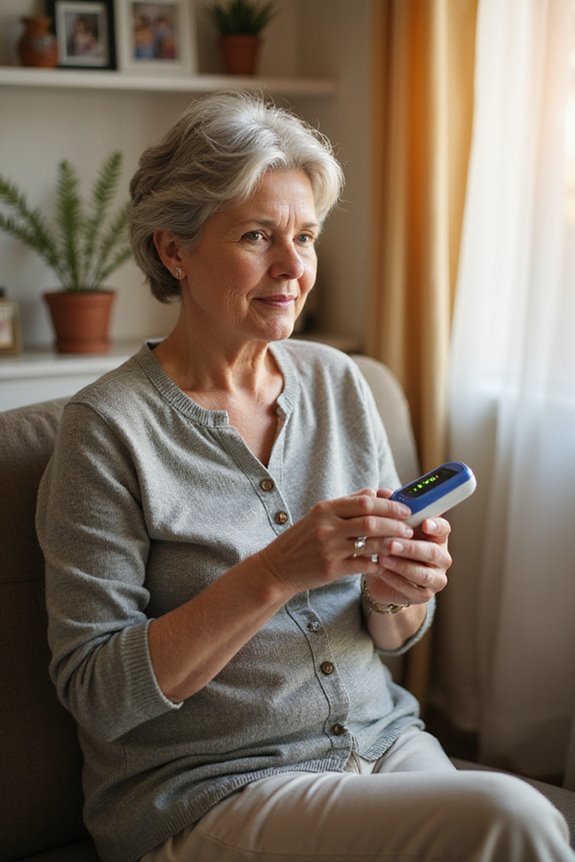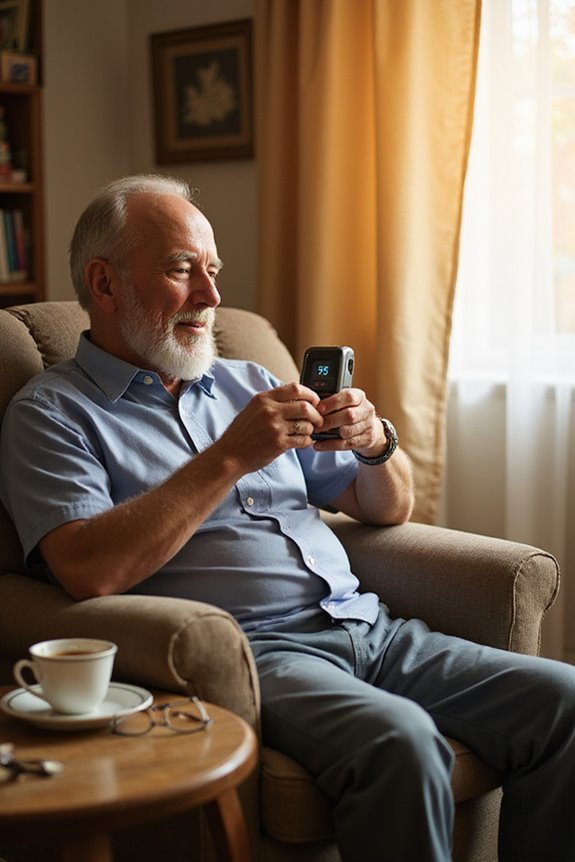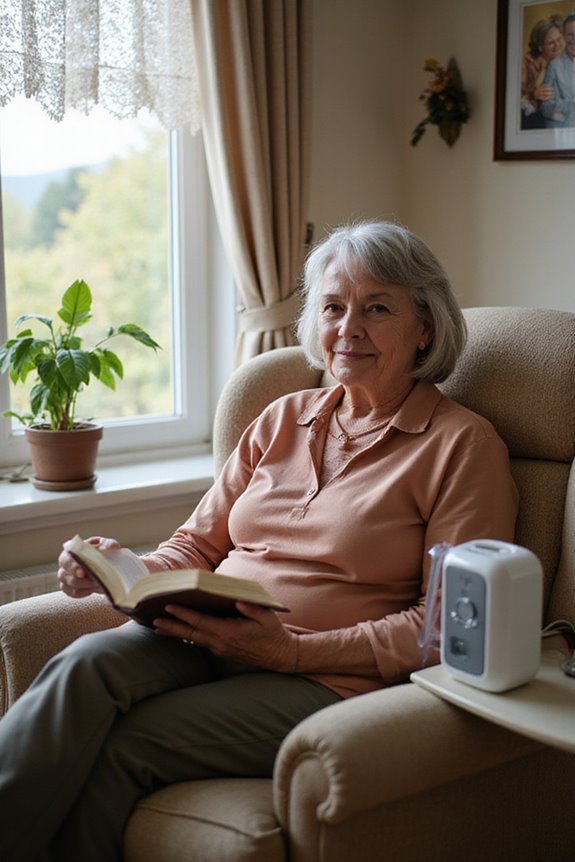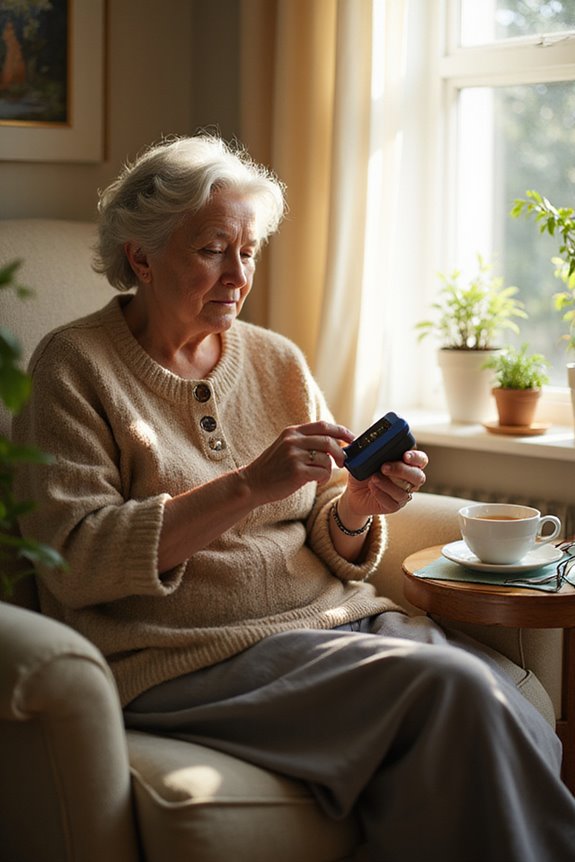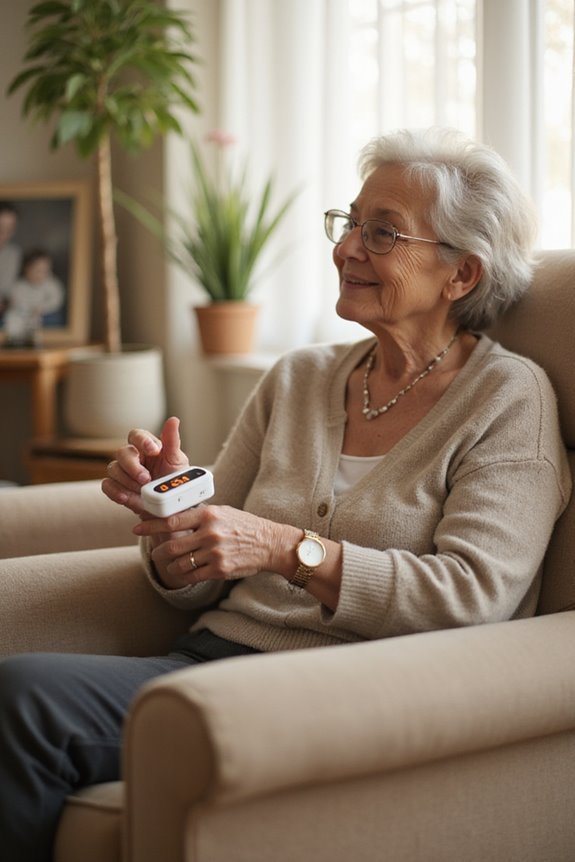A pulse oximeter is a portable electronic device designed for noninvasive measurement of blood oxygen saturation (SpO2) and pulse rate. It operates by emitting red and infrared light through body tissue, typically the fingertip or earlobe. Normal SpO2 values range from 95-100%. These devices are essential in monitoring chronic respiratory conditions and during surgical procedures. They provide immediate readings, enhance patient comfort, and promote timely medical interventions. Additional insights on pulse oximeters will follow.
Key Takeaways
- A pulse oximeter is a portable device that measures blood oxygen saturation noninvasively, typically using a fingertip or earlobe.
- It operates by emitting red and infrared light to assess oxygen saturation (SpO2) as a percentage, with normal levels between 95-100%.
- The device also provides real-time pulse rate (BPM) monitoring, which aids in tracking heart health.
- Pulse oximeters are widely used in medical settings for various conditions, including respiratory and cardiac issues.
- They offer a noninvasive and cost-effective method for continuous monitoring and early detection of critical health conditions.
Definition and Basic Function
A pulse oximeter is a small, portable electronic device designed for the noninvasive measurement of blood oxygen saturation. This device operates by emitting red and infrared light through body tissue, typically the fingertip or earlobe.
Clinical Significance:
- Measures oxygen saturation (SpO2) as a percentage, with normal values ranging from 95-100%.
- Provides pulse rate in beats per minute (BPM), facilitating real-time monitoring.
Device Design:
- Composed of light sources (LEDs), photodetector sensors, a microprocessor, and a display screen.
- Offers quick, painless measurements without the need for blood samples or needles.
The pulse oximeter exemplifies efficient medical technology, ensuring accessible monitoring in various settings and is especially effective when utilizing advanced sensors and algorithms for accurate measurements.
Medical Uses and Applications
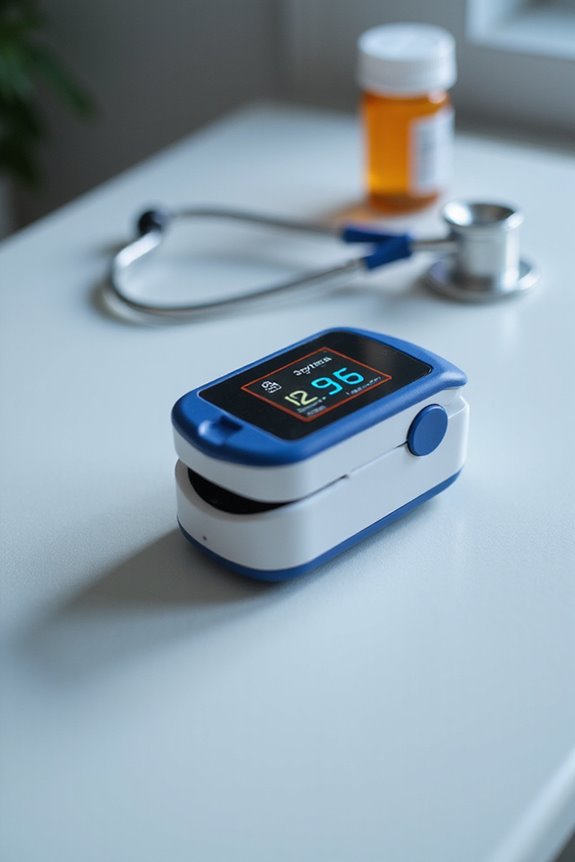
Medical uses and applications of pulse oximeters span a wide range of clinical scenarios, enhancing patient care through noninvasive monitoring of blood oxygen levels.
Respiratory Monitoring
- Monitors oxygen levels in chronic respiratory conditions such as COPD, asthma, and pneumonia.
- Crucial in acute respiratory distress syndrome (ARDS) and sleep studies.
Cardiac Assessment
- Used in cardiac conditions, including heart failure and post-cardiac arrest, to track oxygen saturation.
- Important for patients receiving ventilator support and during resuscitation efforts.
Surgical Applications
– Employed routinely during surgeries to guarantee adequate oxygen delivery under anesthesia.
Chronic Disease Management
– Supports self-monitoring in patients with chronic lung conditions, aiding in early detection of desaturation. Additionally, wireless pulse oximeters enhance convenience and accessibility for patients managing their health at home.
Pulse oximeters consequently play a critical role in various healthcare settings.
How It Works Technologically
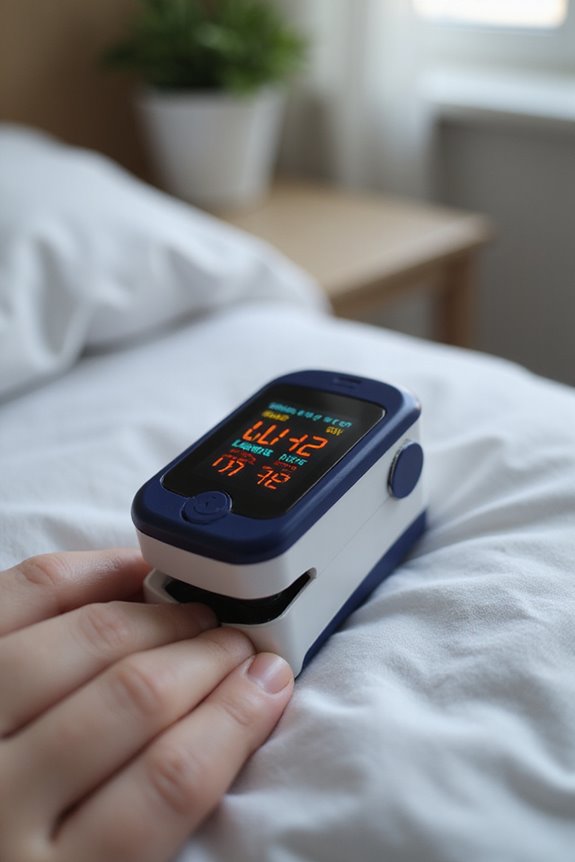
Understanding the technological underpinnings of pulse oximeters reveals the intricate processes that facilitate accurate measurement of blood oxygen levels.
Light Emission and Detection
- Two LEDs emit light at 660 nm (red) and 940 nm (infrared).
- A photodiode measures transmitted light, compensating for ambient conditions.
Signal Processing
- The device isolates the pulsatile signal from non-pulsatile components.
- Sophisticated algorithms subtract the DC component from the total signal.
- The ratio of absorption at the two wavelengths, known as the R value, estimates oxygen saturation.
Calibration and Accuracy
- Devices are calibrated against direct measurements.
- High sensitivity in photodiodes guarantees accurate light detection and data interpretation, enhancing measurement reliability.
Accuracy and Limitations
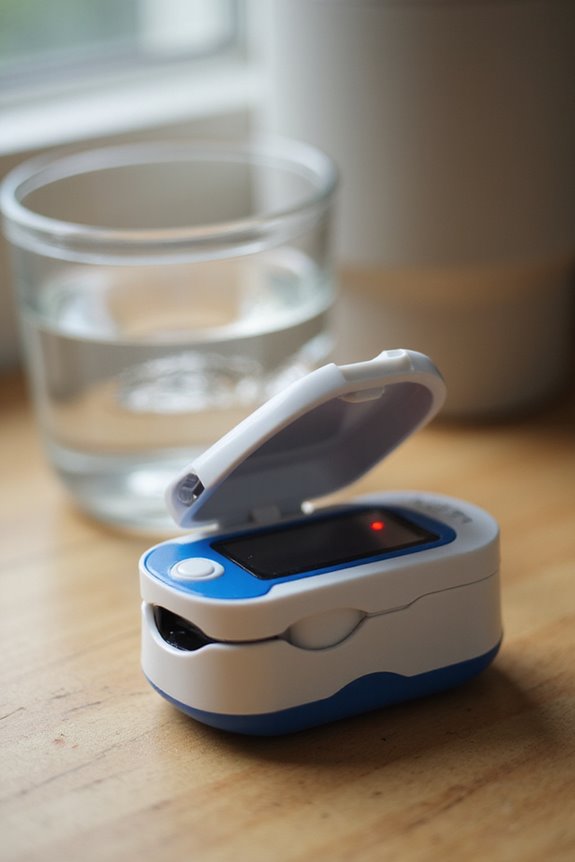
While pulse oximeters are widely used for monitoring blood oxygen levels, their accuracy is influenced by several factors that can lead to discrepancies in readings.
Accuracy Metrics
- FDA-approved devices typically have an accuracy range of ±2–3% at SpO2 values between 70–100%.
- Approximately 66% of readings are within this accuracy, but only 95% fall within ±4–6%.
- Accuracy declines below 90% SpO2, particularly under 80%.
Limitations
- Factors such as poor circulation, skin pigmentation, and external interferences (e.g., nail polish) can affect results.
- Device calibration and brand differences can lead to inconsistent readings.
- Some monitors are designed for specific use cases, such as high-altitude activities, which can impact their accuracy in certain conditions.
Clinical Implications
– Pulse oximeter readings should not replace clinical judgment or arterial blood gas analysis, especially in critical situations, due to potential inaccuracies.
Advantages Over Traditional Methods
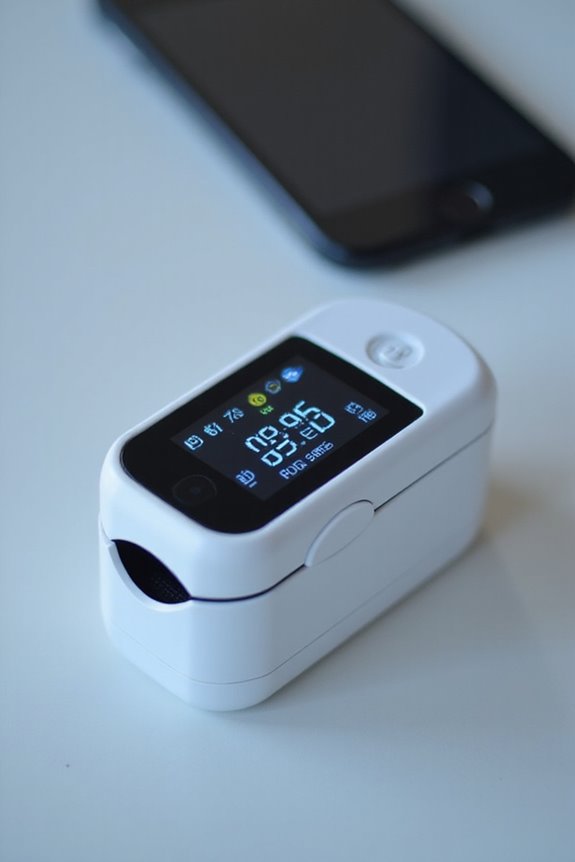
The advantages of pulse oximeters over traditional methods of monitoring oxygen saturation are significant, particularly in their noninvasive nature and rapid response capabilities.
- Patient Comfort: Pulse oximetry eliminates the need for blood draws, enhancing comfort for patients.
- Monitoring Efficiency: Continuous measurement allows for real-time tracking of oxygen levels, essential in critical care settings.
- Rapid Results: Immediate oxygen saturation readings facilitate quick clinical decisions, reducing potential delays in treatment.
- Wide Application: Suitable for diverse medical environments, from emergency departments to operating rooms, making it a versatile tool.
- Cost-Effective: Compared to blood gas analysis, pulse oximeters lower healthcare costs by minimizing invasive procedures and laboratory testing, promoting efficiency in patient monitoring. Additionally, measurement accuracy ensures reliable SpO2 levels that are critical for respiratory health.
Regulatory and Safety Information
Regulatory and safety information regarding pulse oximeters is essential for guaranteeing their safe use in clinical settings.
Regulatory Compliance
- In India, pulse oximeters are classified as low-risk Class A medical devices under the Medical Devices Rules, 2017, overseen by the Central Drugs Standard Control Organization (CDSCO).
- Manufacturers must obtain a Manufacturing License (MD-5), while importers require an Import License (MD-15).
Safety Standards
- In the USA, pulse oximeters comply with 21 CFR 870.2700 and 870.2710 regulations.
- Significant modifications demand a new 510(k) premarket notification to guarantee ongoing safety and effectiveness.
Importance of Compliance
– Regulatory compliance is crucial for market access, enhances product credibility, and minimizes legal risks associated with non-compliance.
Factors Affecting Readings
Several factors can considerably affect the accuracy of pulse oximeter readings, influencing clinical decision-making.
Skin Pigmentation
- Darker skin can interfere with light absorption, leading to under-detection of hypoxemia.
- Studies indicate Black patients are nearly three times more likely to experience occult hypoxemia.
Circulation Factors
- Poor peripheral circulation, often due to cold extremities, results in inaccurate readings.
- Warm skin enhances blood flow, improving measurement reliability.
Motion Artifacts
- Excessive movement can produce erroneous readings.
- Improper sensor placement may weaken signals.
Smoking Effects
- Tobacco use alters hemoglobin, leading to distorted readings.
- Carbon monoxide in smokers can falsely elevate SpO2 levels.
Temperature Variations
- Cold temperatures induce vasoconstriction, negatively impacting accuracy.
- Extremes may prevent pulse registration altogether.
Interpretation of Results
Accurate interpretation of pulse oximeter readings is essential in clinical settings, as these measurements provide insights into a patient’s oxygen saturation levels. Normal saturation levels range from 95% to 100%.
- Readings below 92% may indicate hypoxia; medical consultation is necessary.
- Levels at or below 88% require immediate medical attention.
- Individuals with lung conditions may have different acceptable ranges.
Trends in readings over time are vital, as isolated values may not reflect overall health. For instance, saturation levels between 90% and 94% should be monitored, while below 90% typically necessitates supplemental oxygen.
Accuracy varies, with the highest reliability found between 90% and 100%. Factors such as patient movement and skin pigmentation can influence results.
Home Monitoring and Portability
How can home monitoring of oxygen saturation enhance patient care? Pulse oximeters enable continuous tracking of blood oxygen levels and pulse rates from home, promoting home accessibility and patient convenience for managing chronic respiratory conditions. FDA-cleared devices guarantee accurate measurements, essential for effective treatment planning.
Key features include:
- Real-time alerts for patients and physicians when readings exceed safety thresholds, allowing for early intervention.
- Portable, battery-operated devices that provide quick results, supporting frequent self-monitoring.
- Integration with smartphones for secure data transmission, facilitating remote clinical review.
Additionally, key features and specifications of these devices ensure that patients receive reliable and effective monitoring, contributing to improved health outcomes.
Research indicates that home pulse oximetry is linked to lower mortality rates in COVID-19 patients and can reduce hospitalizations by enabling timely outpatient intervention. This optimization of resources contributes to better healthcare outcomes.
Future Developments in Pulse Oximetry
Future developments in pulse oximetry promise to enhance the accuracy and functionality of these essential medical devices.
Advancements in Green Technology
- Research on green-light pulse oximeters aims to improve accuracy by utilizing larger absorbance differences in oxygenated blood.
- These devices reduce errors caused by skin pigmentation, allowing for continuous monitoring during physical activities.
AI Integration
- Next-generation pulse oximeters will feature AI-assisted capabilities for automated patient monitoring.
- Multimodal devices will measure multiple health parameters, optimizing resource use and enhancing patient care.
Signal Processing Improvements
– Proprietary algorithms will enhance signal extraction, providing reliable readings in challenging conditions.
Expansion of Measurement Capabilities
– Pulse co-oximetry will enable the measurement of additional blood constituents, facilitating early detection of critical conditions. This advancement is crucial for effective health monitoring, as it expands the capabilities of traditional pulse oximeters.
Frequently Asked Questions
Can Pulse Oximeters Be Used on Children or Infants?
Pulse oximeters can be effectively used on children and infants, ensuring child safety and infant accuracy. Specialized devices enhance reliability, addressing anatomical differences and movement challenges, ultimately supporting better health outcomes for young patients.
How Often Should I Check My Oxygen Saturation?
In the gentle rhythm of health, oxygen monitoring weaves through life’s tapestry. Adhering to health guidelines, individuals with mild conditions check once, while those with severe illness require vigilant, frequent assessments to safeguard their well-being.
Are There Specific Brands Recommended for Home Use?
In brand comparison for home use, the Masimo MightySat Medical stands out for its reliability. Other notable options include Oxiline Pulse 9 Pro and Zacurate Pro Series 500DL, catering to varying preferences and budgets.
Can I Use a Pulse Oximeter if I Have Nail Polish?
Nail polish effects can dramatically skew reading accuracy, casting shadows of uncertainty over health assessments. To guarantee reliable results, removing polish is wise; otherwise, one risks maneuvering vital decisions shrouded in misleading data and ambiguity.
What Should I Do if My Readings Are Consistently Low?
When faced with consistently low readings, individuals should consult a healthcare provider to address potential health concerns. Monitoring trends and ensuring accurate measurements can help guide appropriate interventions and foster a sense of safety and community.

